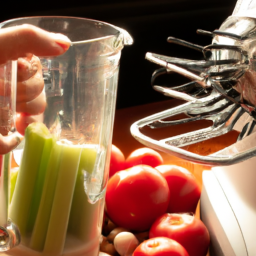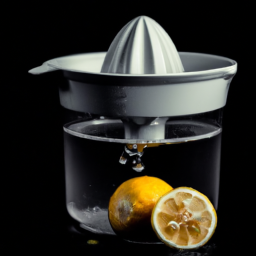I absolutely love clamato juice; there’s just nothing quite like the flavor of a freshly made glass, filled with its unique tangy and savory taste. Making clamato juice at home is surprisingly easy, and it’s a great way to impress your family with your cooking skills.
In this article, I’ll take you through the step-by-step process of making clamato juice, from the ingredients you’ll need to the equipment required and the tips and tricks for getting the perfect taste.
To get started, you’ll need a few basic ingredients, including tomato juice, clam juice, Worcestershire sauce, hot sauce, and lime juice. You’ll also need some equipment, such as a blender or food processor, a fine mesh strainer, and a large mixing bowl.
Making clamato juice is a fun and rewarding experience, and I can’t wait to show you how it’s done!
Key Takeaways
- Making clamato juice at home is easy and requires basic ingredients like tomato juice, clam juice, Worcestershire sauce, hot sauce, and lime juice.
- Experiment with different flavors and spices to find the perfect balance, and adjust the seasoning frequently to ensure that the flavors are well balanced.
- Clamato juice is a good source of vitamins A and C, as well as potassium, and is relatively low in calories and fat.
- Homemade clamato juice can be enjoyed on its own or used as a base for cocktails like a Bloody Mary.
Ingredients needed to make clamato juice
You’ll need some key ingredients to whip up a delicious batch of clamato juice. First and foremost, you’ll need clam juice and tomato juice. The clam juice gives the drink its distinct umami flavor, while the tomato juice adds a sweet and tangy taste. If you don’t have clam juice on hand, you can use canned clams, but keep in mind that the taste may not be as authentic.
For an extra kick, you can add some hot sauce or Worcestershire sauce to the mix. Alternative ingredients can be used to add some variety to your clamato juice. Some people like to add celery salt, black pepper, or even horseradish to their drinks. These ingredients can give the juice a bit more spice and depth.
As for nutritional value, clamato juice is a good source of vitamins A and C, as well as potassium. It’s also relatively low in calories and fat, making it a healthy option for those watching their weight. To move on to the next step, you’ll need some equipment to help you prepare your clamato juice.
Equipment needed
All you need is a blender and a strainer to achieve the perfect combination of tomato, clam, and spices. These essential tools are readily available in any kitchen, making the process of creating your own clamato juice a breeze.
When it comes to the blender, the best brands to use are Vitamix and Blendtec, as they’re powerful enough to blend all the ingredients smoothly without any lumps. For the strainer, a fine mesh one is recommended to ensure that the juice obtained is smooth and free of any particles.
Once you have your blender and strainer ready, creating your own clamato juice is a simple process. First, you need to blend the tomatoes, clam juice, and spices together until you get a smooth consistency. Next, you strain the mixture using the fine mesh strainer to remove any solids and create a smooth liquid.
With this easy-to-follow process, making your own clamato juice at home has never been simpler.
Step-by-step instructions
Okay, let’s get started with making our clamato juice! First, I’ll mix together the clam juice, tomato juice, and all the spices in a large pitcher.
Then, I’ll use a blender to thoroughly blend the mixture until it’s smooth.
Next, I’ll strain the juice through a fine mesh strainer to remove any pulp or seeds.
Finally, I’ll store the juice in a tightly sealed container in the refrigerator until it’s ready to be served.
This process is simple but yields a delicious, homemade clamato juice that’s perfect for any occasion.
Mixing the ingredients
Once you’ve gathered all the necessary ingredients, it’s time to start mixing them together to create the perfect blend of sweet and savory flavors in your homemade clamato juice. There are many mixing techniques you can use to achieve the desired taste, but the most important thing is to experiment with different flavors until you find the perfect balance.
To start, combine the clam juice and tomato juice in a large pitcher. Stir the mixture together until it’s well-blended and smooth.
Next, add the Worcestershire sauce, hot sauce, and lime juice to the pitcher, and mix everything together again. Take a taste of the mixture and adjust the seasonings as needed, adding more hot sauce or lime juice if you prefer a spicier or tangier drink.
Once you’re happy with the flavor, move on to the next step of blending the mixture until it’s completely smooth and frothy.
Blending the mixture
As you start blending the mixture, imagine you’re crafting a masterpiece – the smooth and frothy texture elevating the flavors to new heights.
Blending techniques are crucial to achieving the perfect consistency for your clamato juice. You can use a blender, food processor, or immersion blender depending on your preference.
When blending, experiment with different flavors to find the perfect balance. Add more clam juice for a brinier taste, or more tomato juice for a sweeter profile. Don’t be afraid to add spices like cumin, chili powder, or celery salt to give your clamato juice a unique twist.
Once you’ve achieved the desired consistency and flavor, it’s time to move on to the next step – straining the juice.
Straining the juice
Now that we’ve blended the mixture, it’s time to move on to the next step in making homemade clamato juice – straining the juice. This step is crucial if you want to remove any pulp or sediment from the final product.
To do this, I like to use a fine mesh strainer to ensure that the juice is as smooth and clear as possible. To strain the juice, simply place the strainer over a large bowl or pitcher and pour the blended mixture through it. You may need to use a spatula or spoon to help push the juice through the strainer and remove any excess pulp.
Once you’ve strained all of the juice, discard any remaining pulp and sediment in the strainer. And voila – you now have freshly strained clamato juice that’s ready to be enjoyed!
Now that we have strained the juice, it’s time to move on to the final step – storing the juice. To ensure that your homemade clamato juice stays fresh and flavorful, it’s best to store it in an airtight container in the refrigerator. This will help preserve the taste and quality of the juice for up to a week.
So let’s grab a pitcher or bottle and get ready to store our delicious homemade clamato juice!
Storing the juice
To ensure your homemade clamato juice remains fresh and flavorful, store it in an airtight container in the refrigerator. Preservation methods are important to keep in mind when making your own clamato juice.
The best containers to use are glass or plastic bottles with tight-fitting lids. It’s also important to store the juice in the refrigerator as soon as possible after making it to prevent bacterial growth.
When storing the juice, make sure to leave some room at the top of the container for expansion, especially if using plastic bottles. It’s also a good idea to label the container with the date the juice was made to keep track of its freshness.
If stored properly, homemade clamato juice can last up to a week in the refrigerator. To take your clamato juice to the next level, there are some tips and tricks for perfecting it.
Tips and tricks for perfecting your clamato juice
I’ve found that adjusting the seasoning is crucial for achieving the perfect balance of flavors in my clamato juice. Sometimes I’ll add a little extra celery salt or Worcestershire sauce to give it an extra kick.
Adding citrus, like a squeeze of fresh lime or lemon, can also brighten up the flavor and add a refreshing twist. And if I’m feeling adventurous, I’ll experiment with different spices, like cumin or smoked paprika, to add a unique depth of flavor to my clamato juice.
Adjusting the seasoning
As you’re adjusting the seasoning, you’ll want to taste the clamato juice frequently to ensure that the flavors are well balanced. Depending on your preference, you can make your clamato juice either spicy or mild. To make it spicy, you can add a few dashes of hot sauce or a pinch of cayenne pepper. If you prefer it mild, you can omit these ingredients altogether.
Another important factor in adjusting the seasoning is determining whether or not to add salt. Some people prefer their clamato juice to have a salty taste, while others find it too overpowering. If you do decide to add salt, start with a small amount and gradually add more until you reach your desired level of saltiness.
Once you’ve adjusted the seasoning to your liking, you can move on to the next step of adding citrus for extra flavor.
Adding citrus for extra flavor is a great way to enhance the taste of your clamato juice. In the next section, we’ll discuss how to add citrus and which types of fruits work best.
Adding citrus for extra flavor
You can really enhance the flavor of your clamato by adding citrus – just imagine the zesty burst of flavor it’ll bring to your taste buds! Citrus combinations are a great way to add depth and complexity to your clamato juice.
Some popular flavor pairings include lime, lemon, and grapefruit. Lime is a classic choice for adding a tangy kick to your clamato. You can either squeeze the juice directly into the juice or cut the lime into wedges and use them as a garnish.
Lemon adds a slightly sweeter note and pairs well with the seafood flavor of the clamato. Grapefruit is a bolder choice, but its bitterness can balance out the salty and savory components of the clamato. Experiment with different citrus combinations to find your perfect match.
Next, let’s talk about experimenting with different spices to take your clamato to the next level.
Experimenting with different spices
Feeling adventurous in the kitchen? Why not spice up your clamato with some unexpected flavors like cumin or smoked paprika? Adding different spices to your clamato juice can create a unique and delicious flavor profile that will impress your guests.
Here are three spice combinations to try in your next batch of clamato juice:
-
Cumin and Lime – the warm, earthy flavor of cumin pairs perfectly with the tartness of lime juice. Add a pinch of salt to bring out the flavors even more.
-
Smoked Paprika and Garlic – for a smoky, savory twist on your traditional clamato juice, try adding a dash of smoked paprika and a clove of minced garlic. This combination is perfect for a Bloody Mary-style drink.
-
Curry Powder and Coconut Milk – for a tropical take on your clamato juice, mix in some curry powder and coconut milk. The sweetness of the coconut milk will balance out the boldness of the curry powder, creating a delicious and unexpected flavor.
Once you’ve added your chosen spices, give your clamato juice a taste test. Adjust the seasonings as needed until you’ve found the perfect balance.
With these unique spice combinations, your clamato juice will be the talk of the party. Ready to try even more variations on the classic clamato juice recipe? Let’s explore some exciting twists on the traditional recipe that will take your clamato juice to the next level.
Variations on the classic clamato juice recipe
I love experimenting with different variations of the classic clamato juice recipe to add some spice and excitement to my drink. One of my go-to variations is spicy clamato juice, which is perfect for those who love a little kick in their drink.
Another fun option is clamato juice with tequila, which is a perfect drink to enjoy during happy hour or a night out with friends.
Lastly, for those who prefer a more refreshing taste, clamato juice with beer is a great option to try out.
Spicy clamato juice
Get ready for a kick of heat with this spicy clamato juice recipe! If you’re someone who loves a good spicy cocktail, then this one is definitely for you.
Here are some key ingredients and steps to make this delicious drink:
- Clamato juice
- Hot sauce
- Worcestershire sauce
- Lime juice
- Celery salt
Start by adding a couple of dashes of hot sauce to your glass of Clamato juice. Then, add a splash of Worcestershire sauce and a squeeze of lime juice. Finally, sprinkle some celery salt over the top and give it all a good stir.
Once you’ve made your spicy clamato juice, it’s time to think about what food pairings would work well with this drink. Some great options include spicy seafood dishes, grilled meats, or even a spicy vegetarian chili.
And if you’re looking for other cocktail recipes to try, be sure to check out the next section on Clamato juice with tequila.
Clamato juice with tequila
When you’re in the mood for a tasty and refreshing cocktail, add a splash of tequila to your Clamato for a zesty twist that will leave you craving more. Tequila pairing with Clamato juice is a match made in heaven. The smoothness and richness of tequila blend perfectly with the tangy and spicy flavor of Clamato juice. The combination of tomato juice, spices, and tequila creates a refreshing and invigorating drink that is sure to impress your guests.
To make this delicious cocktail, start by filling a glass with ice and adding a shot of your favorite tequila. Then, pour in Clamato juice until the glass is almost full. To add even more flavor, sprinkle some salt and pepper on top and stir. As for garnish ideas, sliced jalapeños, lime wedges, and celery stalks are great options that will add an extra kick to your drink.
Now that you know how to make a Clamato juice with tequila, it’s time to move on to the next section and learn about the perfect pairing of Clamato juice with beer. Let’s explore how this combination can take your cocktail game to the next level.
Clamato juice with beer
Ready to take your cocktail game to the next level? Mix up a delicious Clamato and beer combo that will leave your taste buds begging for more.
This beer pairing is perfect for those who love a savory and slightly spicy flavor profile. The Clamato juice adds a unique twist to the classic beer, making it a refreshing and exciting drink option.
When it comes to choosing the right beer for your Clamato juice, there are a few options to consider. A light Mexican lager or pilsner works well, as it won’t overpower the Clamato juice’s flavor profile. Alternatively, a crisp and refreshing wheat beer or a hoppy IPA can also complement the savory taste of the Clamato juice.
Experiment with different beer styles to find your perfect flavor combination.
Ready to serve up this delicious drink? Keep reading for some serving suggestions that will take your Clamato and beer combo to the next level.
Serving suggestions
For a refreshing twist, try serving your clamato juice over ice with a slice of lime. This simple addition can elevate the taste and presentation of your drink.
But why stop there? Here are some spice pairings and presentation ideas to make your clamato juice stand out:
- Sprinkle in some celery salt or Old Bay seasoning for a savory kick.
- Add a few dashes of hot sauce for a spicier version.
- Serve in a chilled glass rimmed with Tajin seasoning for a Mexican-inspired twist.
- Garnish with a skewered shrimp or a slice of cucumber for a fancy touch.
- Mix in some tequila and serve in a salt-rimmed glass for a delicious and boozy cocktail.
By incorporating these ideas, you can impress your guests and take your clamato juice to the next level.
And don’t forget, besides being tasty, clamato juice also has health benefits. Let’s explore them in the next section.
Health benefits of clamato juice
I’m really excited to talk about the health benefits of clamato juice. Not only is it a delicious drink, but it’s also packed with essential vitamins and minerals.
Plus, it’s low in calories, making it a great choice for anyone trying to watch their weight.
Some studies even suggest that there may be potential health benefits from the combination of clams and tomatoes in this unique beverage.
Rich in vitamins and minerals
You’ll be happy to know that clamato juice isn’t just delicious, but it’s also rich in vitamins and minerals.
In fact, just one cup of clamato juice provides over 50% of your daily recommended intake of vitamin C. It’s also a great source of potassium, magnesium, and vitamin A.
These essential nutrients are necessary for maintaining healthy blood pressure, strong bones, and healthy vision.
One of the benefits of drinking clamato juice is that it’s widely available in grocery stores and restaurants. It’s an easy way to incorporate vitamins and minerals into your diet without having to spend time preparing meals.
However, it’s important to note that clamato juice does contain added salt, which can be a drawback for those with high blood pressure.
Nonetheless, overall, clamato juice is a healthy and tasty option to consider. Plus, it’s low in calories, making it a great choice for those looking to maintain a healthy weight.
Low in calories
Don’t overlook the fact that this tasty beverage is also low in calories, making it a great addition to your diet if you’re trying to watch your weight. As someone who’s always looking for healthy alternatives, I appreciate that clamato juice provides nutritional benefits without adding unnecessary calories to my daily intake.
With only around 50 calories per serving, clamato juice is a refreshing and guilt-free way to quench your thirst. In addition to being low in calories, clamato juice also contains a variety of vitamins and minerals that are essential to a healthy diet.
This delicious drink is a good source of vitamin C, which supports a healthy immune system, and vitamin A, which promotes healthy vision and skin. It also contains potassium, an electrolyte that helps regulate blood pressure and supports healthy muscle function.
So, not only is clamato juice a tasty beverage, but it also provides important nutritional benefits. Speaking of benefits, let’s explore the potential health benefits of clam and tomato in the next section.
Potential health benefits of clam and tomato
Although clamato juice is low in calories, it also has potential health benefits due to its main ingredients: clam and tomato. Clams are a great source of protein, vitamins, and minerals, including iron, zinc, and vitamin B12. Tomatoes are rich in antioxidants, particularly lycopene, which has been linked to a reduced risk of heart disease and certain types of cancer.
Aside from its nutritional value, clamato juice also has culinary applications. Its unique flavor profile makes it a popular ingredient in cocktails, particularly the classic caesar cocktail. It can also be used as a base for soups, marinades, and dressings. Additionally, some people use it as a replacement for tomato juice in their favorite recipes to add a hint of umami flavor from the clams.
Transitioning to the next section, the history of the caesar cocktail and clamato juice is just as fascinating as its potential health benefits and culinary uses.
History of the Caesar cocktail and clamato juice
I’ve always been fascinated by the origins of cocktails, and the Caesar is no exception. As a Canadian, I know firsthand how popular this drink is in my home country. But how did it come to be?
I’m excited to explore the history of the Caesar, including its evolution over time and the key factors that have contributed to its enduring popularity.
Origins of the Caesar
You may be surprised to learn that the Caesar, a popular cocktail made with clamato juice, was actually invented in Canada in 1969. The origins of the Caesar can be traced back to the Italian dish, spaghetti alle vongole, which is spaghetti with clams.
The creator of the Caesar, Walter Chell, was tasked with creating a new drink to celebrate the opening of a new restaurant in Calgary. He drew inspiration from the dish and combined clam juice, tomato juice, Worcestershire sauce, and vodka to create the now-iconic cocktail.
The Caesar’s origins have cultural significance in Canada, as it has become a national drink and a staple at many Canadian events and gatherings. The drink even has its own National Caesar Day, celebrated annually on the Thursday before the May long weekend.
The Caesar has also inspired various spin-offs, such as the Bloody Caesar, which uses tomato juice instead of clamato juice. With its unique blend of flavors and Canadian roots, the Caesar has become a beloved cocktail in Canada and beyond. But how did it become so popular in Canada?
Popularity in Canada
Now that we know the origins of the Caesar, let’s talk about its popularity in Canada. As a Canadian myself, I can attest to the fact that the Caesar is a beloved cocktail in our country. It’s practically a staple at any social gathering or brunch outing.
One of the key ingredients that sets it apart from a regular Bloody Mary is clamato juice. Clamato juice is a blend of tomato juice and clam broth, and it’s a popular ingredient not just in cocktails, but also in Canadian cuisine. It’s often used as a base for seafood soups and chowders, and it’s even been incorporated into some popular snack foods like potato chips.
But when it comes to the Caesar, clamato juice adds a unique depth of flavor that can’t be replicated with just tomato juice alone. It’s the perfect complement to the vodka, Worcestershire sauce, hot sauce, and other spices that make up the Caesar’s signature flavor profile.
As clamato juice has become more widely available outside of Canada, the Caesar has gained a bit of a following in other parts of the world as well. But how has the recipe evolved over time? Let’s take a closer look.
Evolution of the recipe
Over the years, the Caesar recipe has undergone some changes, but the classic combination of vodka and clam-infused tomato juice remains the bread and butter of this iconic Canadian cocktail.
The history of Clamato dates back to the 1960s when a Chicago-based juice company came up with the idea of combining tomato juice and clam broth.
The product was an instant hit, especially in Canada, where it became the primary ingredient of the Caesar cocktail.
Clamato juice has a cultural significance in Canada, where it is considered a national treasure and a symbol of Canadian identity.
The drink’s popularity has led to several variations of the original recipe, including spicy and extra spicy versions.
Today, Clamato is not only used in cocktails but also as a base for soups and sauces.
With such a rich history, it’s no surprise that making homemade Clamato juice has become a popular activity in many households.
But if you’re not up for the task, here’s how to buy and store store-bought Clamato juice.
Buying and storing store-bought clamato juice
When it comes to buying and storing store-bought clamato juice, there are several key points to consider.
First and foremost, choosing the right brand is crucial to ensure the best taste and quality.
Proper storage techniques, such as keeping it refrigerated and avoiding exposure to light, can also extend its shelf life and maintain its flavor.
And don’t forget to check the expiration date to ensure it’s still fresh and safe to consume.
Choosing the right brand
Picking the perfect brand of Clamato juice can make all the difference in achieving that delicious, savory flavor for your next cocktail or meal. Before purchasing, make sure to compare prices to ensure you’re getting the best value for your money.
Often, the prices will vary depending on the store or the size of the bottle, so be sure to do your research beforehand. Another helpful tip is to conduct a taste test comparison.
You may find that some brands have a stronger tomato or clam flavor than others. It’s important to find a brand that matches your taste preferences to ensure that your drink or meal tastes as great as possible. Once you’ve picked the perfect brand, it’s important to store it properly to maintain its flavor and quality.
Proper storage techniques
To maintain the flavor and quality of Clamato juice, it’s important to properly store it in the refrigerator after opening. I always make sure to transfer the juice into an airtight container before placing it in the fridge. This helps control the temperature and prevent any air from entering, which can cause the juice to spoil quickly.
When storing Clamato juice, it’s best to keep it at a temperature below 40°F. This ensures that the juice stays fresh and flavorful for a longer period of time. Additionally, to extend its shelf life, I always make sure to consume the juice within 7-10 days of opening. This not only prevents spoilage but also helps maintain the taste and quality of the juice.
With proper storage techniques, you can enjoy Clamato juice for an extended period of time.
As important as proper storage is, it’s also essential to know the shelf life and expiration dates of Clamato juice.
Shelf life and expiration dates
Understanding the shelf life and expiration dates of your favorite drinks can save you from potentially harmful health consequences and wasted money. Clamato juice, like any other juice, has a shelf life and expiration date that you should be aware of.
The shelf life of clamato juice depends on whether it is packaged or homemade. Packaged clamato juice typically has a shelf life of around 12 months, while homemade clamato juice can last for up to 5 days when stored in the refrigerator. To extend the shelf life of homemade clamato juice, it’s important to store it in an airtight container and keep it refrigerated. You can also add a small amount of vinegar or lemon juice to the juice to increase its acidity, which will help to preserve it for longer.
Ways to tell if clamato juice has gone bad include changes in color or texture, a foul odor, or a sour taste. If you notice any of these signs, it’s best to discard the juice to avoid any potential health risks.
Frequently Asked Questions
Can I use fresh clams instead of canned clams to make clamato juice?
Yes, fresh clams can be used to make Clamato juice. The recipe variations with fresh clams are endless – from roasted clams to sautéed clams. Experiment with different flavors to find your perfect blend.
How long does homemade clamato juice last in the fridge?
The shelf life of homemade clamato juice in the fridge is around 5-7 days. To prolong its freshness, store it in an airtight container and keep it refrigerated at all times.
Can I add alcohol to my homemade clamato juice to make a Caesar cocktail?
Yes, you can add alcohol to your homemade clamato juice to make a caesar cocktail. Vodka is the traditional choice, but feel free to experiment with recipe variations by substituting gin or tequila for a unique twist on this classic drink.
Are there any substitutes for Worcestershire sauce in the recipe?
When making a Caesar cocktail, Worcestershire sauce is a key ingredient, but if you don’t have it, there are substitute options. Soy sauce or fish sauce can be used, but they will give the drink a different flavor variation.
Can I use a blender instead of a juicer to make clamato juice?
Blending clamato ingredients creates a chunky mess, not juice. A juicer strains the mixture, producing a smooth consistency. Homemade is better than store bought. Use a juicer, not a blender.
Conclusion
Well, that’s it! You now know how to make clamato juice from scratch. With just a few simple ingredients and some basic kitchen equipment, you can create a delicious and refreshing drink that’s perfect for any occasion.
Whether you’re hosting a summer barbecue, enjoying a lazy afternoon by the pool, or just looking for a new twist on your favorite cocktail, clamato juice is sure to hit the spot.
But before we go, let me ask you this: can you imagine the satisfaction of serving up a homemade clamato juice to your friends and family? The look on their faces as they take that first sip of your expertly crafted beverage? The pride you’ll feel knowing that you created something truly special?
So what are you waiting for? Get in the kitchen, grab your ingredients, and start mixing! Your taste buds (and your guests) will thank you.
Ilana has been a vegan for over 10 years. She originally made the switch for health reasons, but soon found herself becoming more and more passionate about the ethical and environmental implications of a vegan lifestyle. Ilana is the author of The Graceful Kitchen, a blog all about veganism. She loves to cook up delicious and nutritious vegan meals, and share her recipes with others who are interested in leading a cruelty-free life. Ilana is also a strong advocate for using whole foods as the foundation of a healthy diet, and believes that going vegan is one of the best ways to achieve this.










